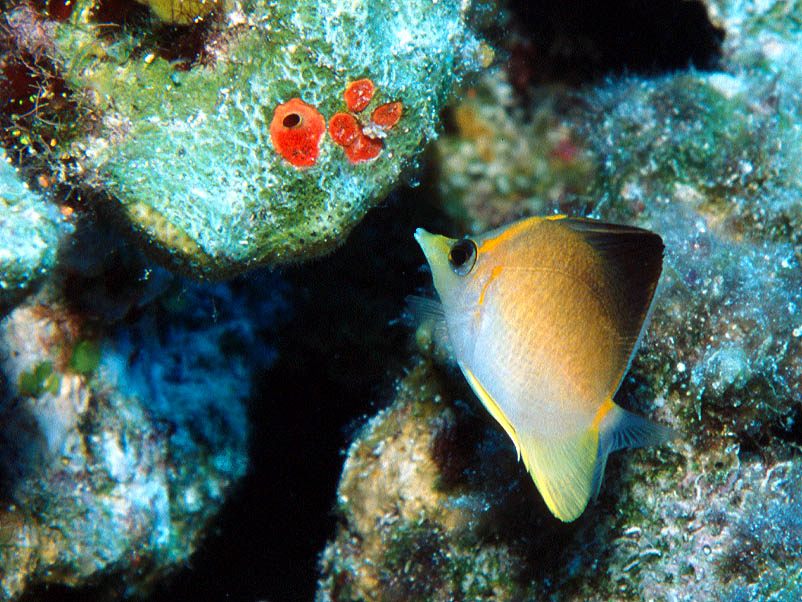

The Longsnout Butterflyfish one of the most elusive fish I've ever photographed. If it wouldn't take too long to tell, the tale of how it took me 7 years to photograph this tiny fish would make a great story...
The Longsnout Butterflyfish is very different from most of the other Butterflyfishes. First, it is tiny. This adult Longsnout Butterflyfish was only 3 inches long. Its body shape is very different from other Butterflyfishes. Like other types of Butterflyfishes, the Longsnout Butterflyfish has a tall and narrow body. It has a snout that is much longer in proportion to the snouts of other Butterflyfishes, giving this fish its name. This snout allows it to reach into cracks and crevices where it catches the worms, coral polyps, and other small animals that it eats. The Longsnout Butterflyfish swims by paddling with the pectoral fins on its sides as it steers with its tail. This picture shows its clear pectoral fins against the dark shadow of the crevice. Also notice how it has curled its tail to the side as it turns to the left to see what I am going to do. If it hadn't turned to look at me, I never could've taken this photograph... Also notice that its caudal (tail) fin is clear. This makes the Longsnout Butterflyfish look like a flying triangle. Notice the many orange markings, especially above its eye and at the base of its tail.
Also notice the bright line like an arch on the side of this Longsnout Butterflyfish. This bright line is called a lateral line, and is a type of sound sensor that works like a second set of ears to allow the fish to detect vibrations in the water. Most fishes have lateral lines. The lateral line is one of the things that helps this Longsnout Butterflyfish to be so elusive.
Notice that this particular spot on the coral reef was not very healthy. The corals here have died and are now covered by green algae plants and white hydroid animals. There are four bright red-orange spots of a Red Boring Sponge on the coral just in front of the Longsnout Butterflyfish. The Red Boring Sponge is a colony of thousands of tiny invertebrate animals. Like other sponges, the animals pump water through the colony and out the large hole on its surface, filtering food out of the seawater. Read all about that on the ReefNews Yellow Tube Sponge website. But the Red Boring Sponge makes a hole on the reef for itself by attacking the coral and destroying its skeleton. This sponge may extend deep into the coral, and may have led to the death of this coral colony. See a picture of a living Star Coral on the ReefNews Christmas-Tree Worm webpage.
Dr. Jonathan Dowell took this picture at a reef called Sand Castles Reef near San Salvador, The Bahamas in October, 2001. He used a Canon A2 SLR camera with a 28-105mm zoom lens, in an Ikelite housing with an Ikelite Substrobe 200. After stalking Longsnout Butterflyfish with cameras since 1995, Dr. Dowell was finally successful on this dive. This was his 200th dive, accumulating a total time of 123 hours (that's 5 days) underwater in seven years of diving.